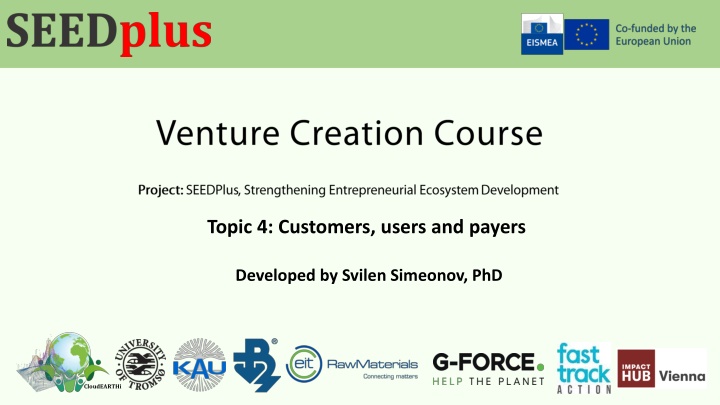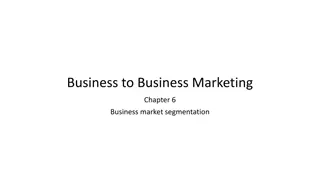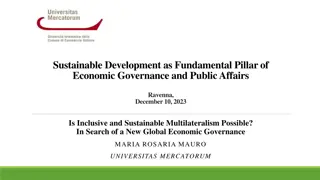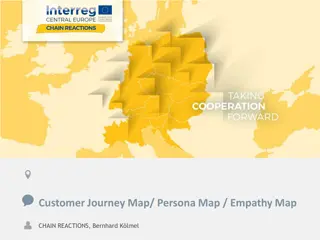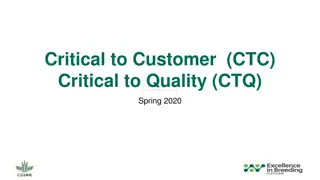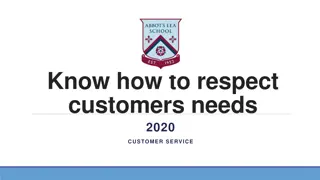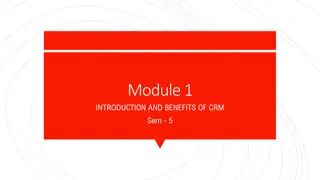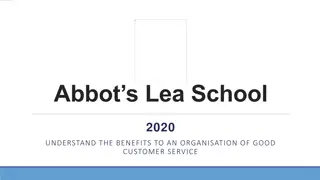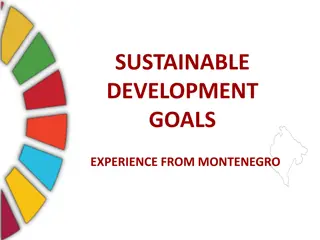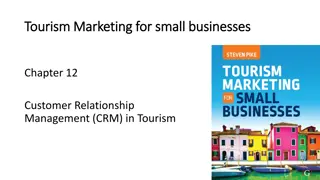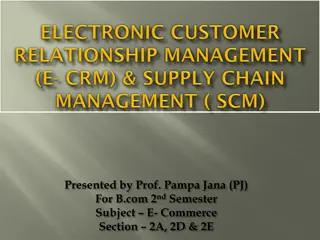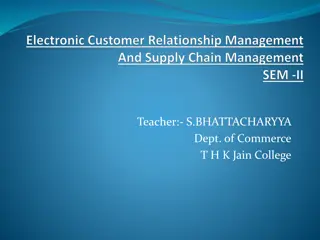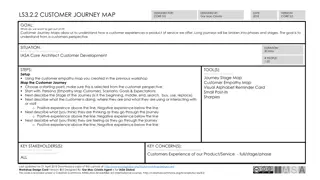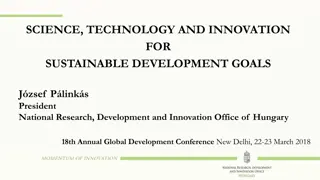Evolution of Customer Roles in Sustainable Business Development
The evolution of technology has empowered consumers to make informed choices and payments, transforming them into clients, consumers, and payers. Businesses must adapt to satisfy diverse customer desires in real-time to achieve sustainable development and create active customers. Shifting from sales-centric approaches to customer-centric models is crucial for attracting and retaining active customers and partners. Understanding customer lifecycles and needs at each stage is pivotal for sustainable business growth.
Download Presentation

Please find below an Image/Link to download the presentation.
The content on the website is provided AS IS for your information and personal use only. It may not be sold, licensed, or shared on other websites without obtaining consent from the author.If you encounter any issues during the download, it is possible that the publisher has removed the file from their server.
You are allowed to download the files provided on this website for personal or commercial use, subject to the condition that they are used lawfully. All files are the property of their respective owners.
The content on the website is provided AS IS for your information and personal use only. It may not be sold, licensed, or shared on other websites without obtaining consent from the author.
E N D
Presentation Transcript
Topic 4: Customers, users and payers Developed by Svilen Simeonov, PhD CloudEARTHi
Sustainability and sustainable business through ecosystems The rapid development of technology, particularly information technology, provides members of society with the opportunity for informed consumer choice from a growing array of alternatives. A good example of such choice is making reservations on various internet platforms [1] reservations for plane tickets, hotels, package deals, etc. In these platforms, one can choose from multiple options for primary reservation, while simultaneously booking additional services (parking space, taxis, car rentals, etc.). Besides the mentioned choice, the customer can also compare prices of different alternatives and select the most desired one for themselves. CloudEARTHi
The provided opportunities for comparison, choice, and payment enable each of us to assume the roles of client, consumer, and payer. In this case, the client makes an informed choice to the extent that they are willing to make a purchasing decision or reject it (a decision to postpone the purchase is also possible). The decision to purchase transforms the client into a consumer of goods and/or services that possess a certain value and satisfaction for them. The decision to purchase not only transforms the client into a consumer but also into a payer, according to the agreed conditions at the conclusion of the transaction (regardless of the timing and form of payment). The reached technological level allows each of us to continuously be in one or simultaneously in several of the mentioned roles client, consumer, and payer. Regardless of the role, each client desires and demands immediate satisfaction of their personal needs, desires, and requirements the need to solve a specific problem, which for each individual client is the most significant and with the highest priority. The development of technology changes the current needs, desires, and requirements of clients, continuously and with increasing intensity, creating new ones. This poses significant challenges for entrepreneurs in ensuring maximum satisfaction for their customers a good prerequisite for creating active customers. This satisfaction is fundamentally important for achieving sustainable business development strategic development (achieving strategic goals) of the business while considering social, environmental, and business interests. CloudEARTHi
To meet these challenges, businesses and entrepreneurs are shifting from achieving successful sales to satisfying the increasing variety of customer desires. Furthermore, entrepreneurs must be able to provide opportunities for the customer to manage their choice and its effects in real-time. The success of entrepreneurs in meeting these desires has its dimensions, with a key one being reaching a "critical mass" of active customers and partners, capable of providing the driving force for achieving sustainable business development. Achieving such mass requires businesses and entrepreneurs to change not only their approach to customers but also their model for attracting them, as active ones. This necessitates a transition from an approach focused on sales of products and services while adhering to their lifecycle to adopting an approach focused on sales to active customers while considering the lifecycle of customers, suppliers, and partners stakeholders regarding business sustainability. Customer lifecycle orientation, specifically towards their desires and needs manifested at each stage of their lifecycle, is of crucial importance for business success. CloudEARTHi
To satisfy the identified desires of the customer, the entrepreneur creates an ecosystema well-balanced system of efficiently interacting suppliers and partners, regardless of each one being at a different stage of its lifecycle and having different involvement in the business a business ecosystem. In this system, balance is crucial to ensure maximum satisfaction for each individual customer. The customer is treated as a king, and the entrepreneur adapts, adjusts, and directs their ecosystem towards the customer's desires, aiming to achieve maximum satisfaction and a maximum number of active customers. This necessitates adopting a holistic approach when starting and developing a customer-oriented business. Applying this approach leads to the establishment of business ecosystems oriented towards the customer. CloudEARTHi
The concept of an ecosystem is borrowed from ecology, where it is most commonly associated with a community of organisms interacting in the environment to provide mutual benefit. It is accepted that ecosystems that are larger and possess greater biodiversity are more resilient to impacts from other organisms and natural catastrophes that could threaten the existence of the ecosystem. These characteristics allow for an analogy to be drawn and transferred to the concept of business ecosystems and specifically to ecosystems oriented towards consumers. In these ecosystems, entrepreneurs, partners, and suppliers establish an effective symbiosis that, if at the right scale and with the necessary efficiency, ensures the best and most efficient satisfaction of the wide and growing spectrum of customer desires. Achieving a high and comprehensive level of satisfaction for all customers leads to a rapid increase in their number, as active users. This is the necessary prerequisite for reaching the critical mass of customers, which provides a resource for sustainable business development. CloudEARTHi
Business ecosystems and those oriented towards consumers Providing a unique experience and satisfaction for each customer necessitates the construction of dynamically changing ecosystems oriented towards consumers, both in scale and structure. These are adaptive systems capable of changing rapidly, making it difficult to define permanent rules, norms, and frameworks for them. The adaptability of the ecosystem is due to its ability to freely realize, connect, communicate, combine, and undertake joint and well-coordinated actions by and between its participants. This ensures the possibility of unlimited combinations of resources, capacity, knowledge, and experience within the ecosystem. This provides the ecosystem with a wide range of opportunities to satisfy the desires of its customers. In this way, the ecosystem as a whole achieves higher satisfaction for each customer than each individual participant in the ecosystem separately. Thus, the ecosystem manages to achieve a synergistic effect, which transforms into the attainment of synergistically accumulated value a value greater than the simple sum of values provided by each individual participant in the ecosystem. CloudEARTHi
Building consumer-oriented ecosystems. The process of building a consumer-oriented ecosystem largely maintains the logic of building a successful business but emphasizes the following [1]: Principles of building and the philosophy of the ecosystem; Defining the framework (scope) of the ecosystem at present and in a strategic aspect; Formation of a portfolio of products and services satisfying customer desires; Defining tasks, functions, and goals within the ecosystem; Lean and scale-up of the ecosystem. CloudEARTHi
Philosophy of the ecosystem Building a customer-oriented ecosystem should start with clarifying and defining the mission and vision, which will determine the shape and values of the ecosystem. The mission should reveal the usefulness of the ecosystem for all stakeholders in its success, primarily its customers. The vision of the customer- oriented ecosystem reveals what it aims to achieve in the future in terms of customer satisfaction. The mission, vision, and strategic goals of the ecosystem form a common framework into which developed and well-defined models should fit for: generating value in the ecosystem; transferring value in the ecosystem; a model for maintaining and attracting new active customers - providing a wide range of unique user experiences; a model for developing partner relationships and attracting new partners to the ecosystem. CloudEARTHi
Defining the Framework When defining the framework of the ecosystem, entrepreneurs should carefully assess their knowledge, capabilities, and capacities regarding the management and sustainable development of the built ecosystem [1]. As a result of this assessment, the entrepreneur may adopt and adapt one of three basic strategies for building an ecosystem [1]: Organize the creation and sustainable development of a business ecosystem to be the creator, coordinator, and leader of the ecosystem. Join as a partner in various ecosystems, which are guided/directed by other entrepreneurs. Develop their business by simultaneously applying both of the aforementioned strategies to be a leader in the ecosystem they are developing while also benefiting from opportunities to partner in ecosystems led by other entrepreneurs. CloudEARTHi
After selecting a strategy, the entrepreneur defines a hierarchical system of goals, periodically subjecting them to evaluation for their justification, rationality, and achievability. The frequency or continuity of assessments depends on the hierarchical level and significance of the goals, as well as the nature of the environment in which they are to be achieved. To evaluate goal achievement, they must be clearly defined in time, and the responsible parties for achieving them must be defined responsible at the ecosystem level, partner/supplier, team, and individual levels [1]. Assessing progress towards defined ecosystem goals, as well as its effective functioning, requires the development and implementation of a system of KPIs (key process indicators). These indicators can illustrate the development of the ecosystem according to the defined goals. CloudEARTHi
Portfolio The leader of the ecosystem should organize and coordinate the creation of a common portfolio of the ecosystem. Its creation is primarily based on identified needs and desired experiences of the ecosystem's customers, as well as the ability to address a wide range of customer problems. In creating it, the leader should consider the capabilities and interests of all stakeholders. The ecosystem's portfolio presents carefully selected products and services to its customers in a unique and inspiring way. Creating the portfolio is not a one-time act but a continuous process of evaluation, selection, review, and revision. The goal of this process is to continuously and maximally satisfy the individual and constantly changing desires of the customers. CloudEARTHi
Management and Coordination of Partners A good ecosystem requires reliable partners who possess the necessary knowledge and potential. To ensure such partners, the entrepreneur creating the ecosystem defines parameters/criteria for their selection. The selection, based on these criteria, serves as the basis for creating a collaboration model within the ecosystem. This model, along with the specified criteria, should harmonize with the strategic goals, mission, and vision of the ecosystem. This is a prerequisite for good interaction between ecosystem participants, which is a key factor in ensuring the necessary satisfaction of CloudEARTHi
Building a collaboration model within the ecosystem requires the leader to define the roles of all partners in the ecosystem. Forming such a mechanism of interaction requires defining the obligations and responsibilities over time, both for each partner and for the ecosystem leader themselves. The participating partners, their roles, and responsibilities are subject to continuous monitoring and updating over time. For the flexibility of the ecosystem, its maintenance, and development, relationships with partners need to be clearly and comprehensibly formalized. This applies to achieving goals, forming equity participations, and raising venture capital [1]. Relationships within the ecosystem should be formalized in a way that allows for the quick and seamless exit of partners and the inclusion of new ones. CloudEARTHi
For good coordination and management of the ecosystem, management parameters, standards, and policies need to be defined, unified into a common management model [1]. It should provide flexibility and adaptability to the ecosystem, as well as enabling its rapid growth. The management model should allow for quick analysis, effective control, and prompt, well-informed management decisions. Another model with significant importance for the good coordination, interaction, and management of the ecosystem is the value exchange model. It should be clear, fair, useful, approved, and accepted by all partners in the ecosystem [1]. The model should enable the rapid movement of value, encouraging in the ecosystem: value transfer through profit/revenue distribution; sharing of licensing fees; patents, and others [1]. All partners should be satisfied with the money they make in the ecosystem and be convinced that the growth of the ecosystem will lead to a corresponding fair increase in their benefits from participating in it. CloudEARTHi
Lean and scalable ecosystem The development of new products begins with uncovering the desires and problems of customers. Based on this foundation, the possibility of generating value from newly created products and services is clarified. After clarifying these conceptual possibilities, rapid prototyping processes and the creation of MVPs (Minimum Viable Products) are initiated. The results of these processes provide new scalable products [1]. With the finalization of the development of these foundational products, another process begins, which is related to continuous testing and development. The goal is first to establish how well the products and services meet the desires of the consumers and how successfully they solve their problems, and then to seek opportunities for their enhancement and development. Even at these stages of designing and creating products and services in the ecosystem, the principles of the circular economy should be applied. It is necessary for the design and organization of their production to be in line with the requirements of transitioning to zero emissions, the so-called green deal. CloudEARTHi
Achieving higher satisfaction from products is a prerequisite for higher customer activity and attracting new active customers. This is a source of growth for both the value and the ecosystem itself. To achieve ecosystem growth, it is necessary to identify value streams and create capabilities that generate value in the ecosystem. Thus, identified streams are subject to analysis and assessment, after which they are mapped into systems of indicators and undergo analysis, control, and development. This allows for a better understanding of the interconnection between partners in the ecosystem and reveals the sources of synergy in terms of value. The larger the ecosystem and the greater its diversity, the greater its potential for achieving a high synergistic effect. Such an ecosystem is able to achieve greater economies of scale, lower cost. Larger ecosystems, on the other hand, are more complex and more difficult to manage. This necessitates the application of Lean tools, which can eliminate cross-cutting and duplicative actions, properly orient, and streamline the flows/processes occurring in the ecosystem [4]. CloudEARTHi
Managing Transformations in the Ecosystem Building an ecosystem takes time, and it is advisable not to attempt to build a large ecosystem from scratch and in a short time. Achieving large and effective ecosystems is a process that takes time and is difficult to achieve in the short term, especially in the absence of experience, knowledge, and capacities. It is good for entrepreneurs to start building their ecosystems with the development of their startup business/scale-up of the startup. The development of ecosystems can also start at a later stage in the business lifecycle, but it is desirable not to miss opportunities to build successful ecosystems. A good solution is for ecosystem development to be implemented together with the development of a startup business, at a stage where the entrepreneur owns MVPs. This will allow them to effectively start developing their MVP towards meeting the needs of their customers, under the synergistic effect provided by the ecosystem - created and developed by the entrepreneur. This significantly increases the chance of success. CloudEARTHi
Creating a small and successful ecosystem forms the foundation upon which product development, portfolio growth, and the expanding ecosystem are built. Involving new partners in the ecosystem and products in the portfolio must add value and enhance the synergistic effect in the ecosystem. When the entrepreneur reaches sufficient maturity, they may adopt a different approach, other than forming and developing an ecosystem. They may adopt an approach of independently offering comprehensive solutions to their customers, thereby starting to derive all the benefits generated by economies of scale. However, adopting this approach requires innovation, achieved maturity, and significant business scale. CloudEARTHi
The development of ecosystems implies their transformation in order to provide flexibility, greater customer satisfaction, and the ability to better serve a larger number of customers. When such transformation of the ecosystem occurs, the following should be taken into account [1]: Strategic goals and executed strategic plans; Evaluation of the maturity and motivation of the ecosystem; Management and coordination of transformations, ensuring they do not lead to a deterioration of KPI values; Intermediate goals defined by partners and the desires of customers; Achieving high economies of scale. Transformations in the ecosystem should maintain the ability to generate and increase the synergistic effect regarding value generation. CloudEARTHi
Literature: [1] https://www.porsche-consulting.com/sites/default/files/2023- 04/the_art_of_building_ecosystems_c_2020_porsche_consulting_01.pdf (Date:20.01.2024) [2] https://www.mdpi.com/2071-1050/11/6/1663 (Date: 20.01.2024) [3] https://ojs.aaai.org/index.php/AAAI/article/view/26752 (Date: 20.01.2024) [4] https://lean.bg/lean-project-in-bulgaria/ (Date: 20.01.2024) CloudEARTHi
https://mooc.cloudearthi.com/courses/ CloudEARTHi
